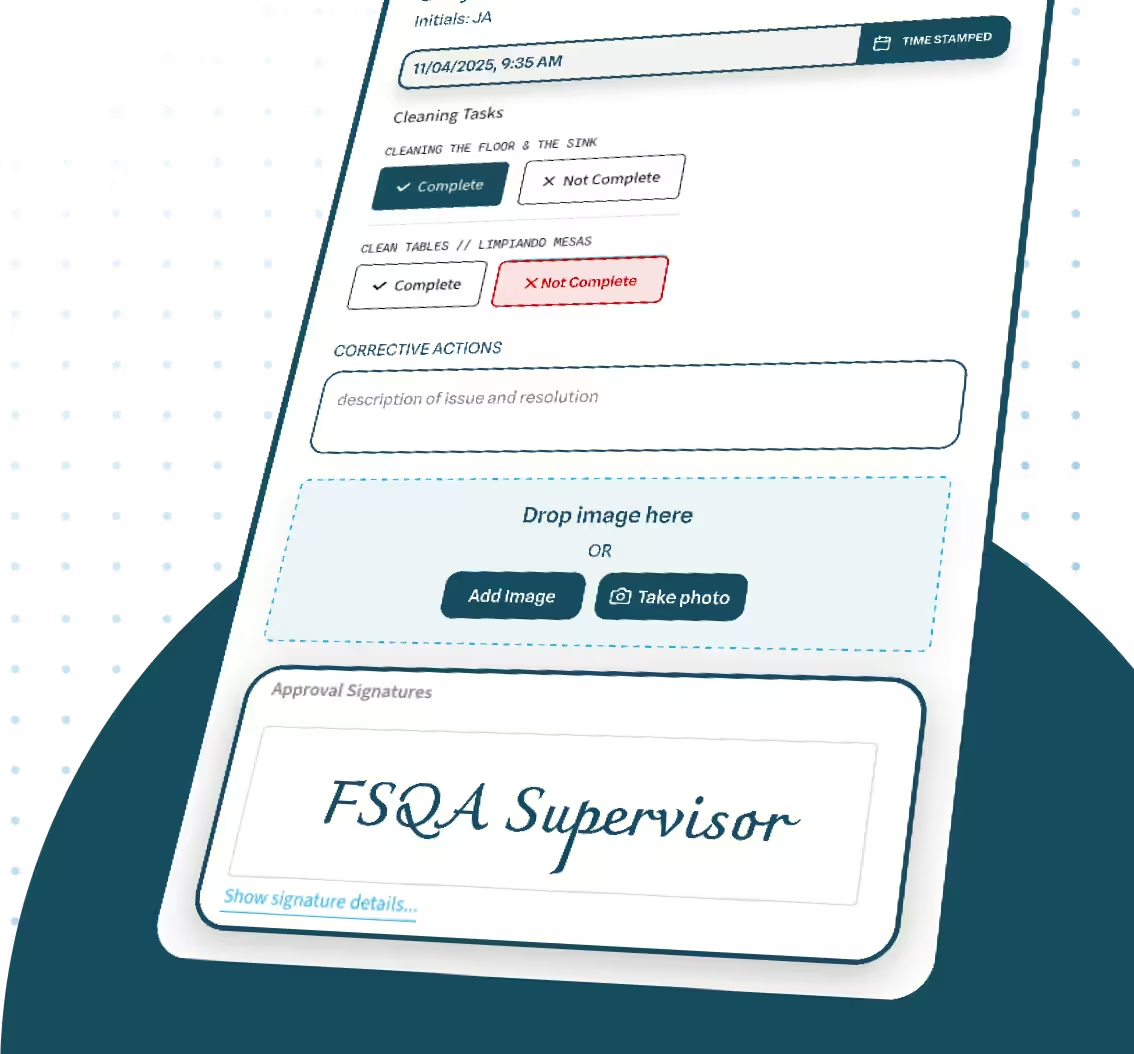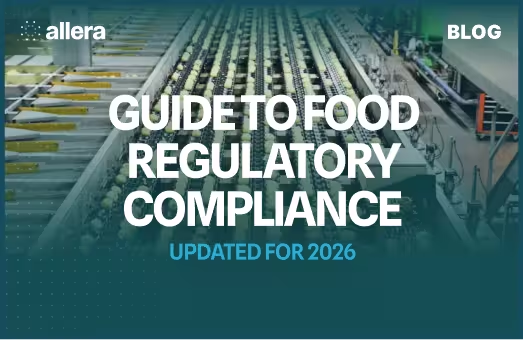

7 Expected Changes Coming in SQF Edition 10 (And How to Get Ready)
.avif)
SQF Edition 10 is rolling out soon, and you want to keep your facility steps ahead. By focusing on the main updates and starting early, you can guide your team through these new requirements with clarity and confidence. Below, you’ll find exactly what to watch for and how to fine-tune your processes so you’re set up for success.
What You Will Learn
- The core shifts in SQF Edition 10 you can expect.
- How to refine your document control system.
- Ways to strengthen supplier audits and allergen management.
- Tips to track digital records and ensure traceability.
- Practical advice to nurture a robust food safety culture.
What is SQF Edition 10?: The SQF Code Update Coming in 2026
The Safe Quality Food (SQF) standard is a globally recognized framework for food manufacturers looking to maintain consistent, high-grade safety practices. SQF Edition 10 takes aim at today’s evolving risks and expectations, recommending improvements that help your site adapt to new scientific findings and modern consumer demands.
A key driver behind this edition is the push toward proactive risk management, so you’ll see an emphasis on predictive strategies—not just reactive solutions. For instance, you may find more detailed guidelines on how to manage microbiological risks in sensitive food lines, or how to assess broader environmental impacts. The overall approach is straightforward: prevention first, then detection, and then swift corrective action.
As you review SQF Edition 10, think about your current structures. Are you fully digital, or do you still rely on paper logs? Do you have consistent training sessions, or do staff members receive scattered refreshers? Being honest about these points helps you pinpoint exactly what to improve. If you’re already performing well under Edition 9, you’ll likely see a few subtle shifts in design and verification requirements. But for many, the effective date can come faster than expected, so it’s smart to get started now.
Below are seven specific changes you can expect, plus actionable steps for preparation.
1. Supplier Audits Under SQF Edition 10: Expanded Requirements
Supplier relationships are the backbone of any safe production line. With SQF Edition 10, you can anticipate expanded requirements around supplier audits, pushing you to verify not only that your vendors meet baseline criteria, but also that they’re aligned with your facility’s risk-level and product category.
Why This Matters
Strong supplier oversight ensures you catch potential hazards before ingredients even enter your building. In some recent food safety incidents, lapses in third-party oversight were the root cause. By upping supplier audits, SQF aims to close that gap and encourage a culture of operational transparency.
How to Prepare
- Review Your Current Checks: Assess how often you conduct audits now, and confirm that frequency will meet the new guidelines.
- Segment Suppliers by Risk: Knowing which ingredients or materials pose higher risk helps you prioritize audit resources.
- Create a Digital Record: Storing all audit findings in an easily accessible system makes it simple to verify compliance over time.
- Plan Vendor Guidance: Supplier partnerships are strongest when you share clear expectations and resources. Consider offering them your best practices to encourage alignment.
For a more efficient way to keep your audit records consistent, consider using Allera’s Document Control Software for effortless management.
2. Document Control in SQF Edition 10: Strong SOP Management Is Getting More Crucial
Monitoring and handling your standard operating procedures (SOPs) has always been vital, but SQF Edition 10 is expected to emphasize it further. Tight document control helps you maintain consistency, limit errors, and present a single source of truth for audits.
Why This Matters
Well-managed SOPs reduce confusion and speed up training. When new team members join, you need a clear set of procedures that match real-world processes. This is especially important if you handle multiple product lines, since each may involve different hazards or require unique cleaning protocols.
How to Prepare
- Standardize All Templates: Make sure every form, checklist, or instruction follows a uniform layout. This consistency simplifies updates.
- Schedule Document Reviews: Plan quarterly or semi-annual reviews to keep all procedures relevant.
- Use Digital Tools like Allera's Document Control: A central digital repository (with version tracking) helps you see at a glance what’s current and what needs updating.
- Train Everyone: Even the best system fails if team members don’t know how to use it. Offer quick how-to sessions and follow up with micro-trainings as you release new SOPs.
3. Allergen Management Updates in SQF Edition 10: New Rules to Prevent Recalls
Food allergies remain a leading cause of recalls, often due to mislabeling or cross-contact. SQF Edition 10 doubles down on allergen control, making sure you have robust tracing and separation procedures in place.
Why This Matters
Allergen-related recalls can spiral into brand damage and consumer harm. While you may already have labeling checks, SQF’s new guidance may require deeper verification—like cross-contact testing or more detailed cleaning logs. This can feel like extra work, but it’s a proven shield against costly mistakes.
How to Prepare
- Identify High-Risk Zones: Map out where allergen ingredients are stored and processed.
- Color-Code Equipment: Distinguish utensils and containers for allergen vs. non-allergen lines.
- Update Label Protocols: Double-check that your packaging lists all allergens clearly according to regional regulations.
- Revisit Cleaning Steps: Ensure each cleaning stage is properly validated to remove allergenic proteins.
4. Food Safety Culture in SQF Edition 10: How to Build Habits That Auditors Notice
Beyond operational details, SQF Edition 10 highlights your team’s mindset. A strong food safety culture isn’t just about protocols. It’s about fostering habits—like speaking up about risks, or showing new hires how to double-check critical control points with confidence.
Why This Matters
Culture matters: when employees naturally watch for hazards, you build protection that written SOPs alone can’t provide.
How to Prepare
- Lead by Example: Managers or supervisors who visibly follow food safety rules encourage the rest of the team to do the same.
- Set Up Micro-Trainings: Short, regular sessions can keep safety themes fresh without overwhelming your staff.
- Acknowledge Honest Feedback: If someone spots a gap or raises a concern, treat that as a win. Recognize their effort so others feel comfortable speaking up.
- Track Culture Metrics: Consider simple ways to measure safety habits, like near-miss reporting frequency or days since last infraction.
Recommended Reading: Our comprehensive guide on How to Build a Strong Food Safety Culture.
5. Environmental Monitoring in SQF Edition 10: What’s Changing and Why It Matters
Environmental monitoring means routine checks for pathogens or contaminants in your facility. In earlier SQF versions, the focus was there, but SQF Edition 10 is likely to increase the rigor, requiring more frequent sampling or a clearer plan on how to isolate root causes if something goes wrong.
Why This Matters
Pathogens can quickly spread in zones you rarely think about, such as drains, condenser units, or tricky corners of your production line. The sooner you detect an elevated count, the faster you can contain it. With more analysis, you’ll see patterns that help you refine your cleaning schedule.
How to Prepare
- Map Sampling Locations: Identify all high-risk spots—especially if you process raw products or have open product exposure.
- Rotate Your Sampling: Change the exact swabbing areas from time to time, so you’re less likely to miss hidden trouble.
- Document Incidents: If you find any pathogen hotspots, note the date, time, and corrective action. SQF auditors appreciate transparency.
- Verify Corrective Actions: After a contamination event, do follow-up tests to confirm the issue is resolved and the fix is sticking.
6. Digital Traceability in SQF Edition 10: Preparing for Faster Recall Readiness
More and more facilities rely on automated systems to track ingredients from supplier to shipment. SQF Edition 10 encourages this digital leap, recognizing that old paper trails can slow you down, complicate recalls, and create accountability gaps.
Why This Matters
If a recall hits, your speed and accuracy in tracing the source can save you thousands in wasted product (and lawsuits). With digital tracking, you have real-time insights. You can pull up a batch number or lot code in seconds, or see how much inventory is currently being used in production lines.
How to Prepare
- Consider an All-in-One Platform: Does your current software handle traceability, or do you rely on multiple spreadsheets? Unifying the process reduces errors.
- Revisit Training: A new tool won’t help unless people actually use it. Coach teams on scanning systems, mobile devices, or data entry best practices.
- Conduct Mock Recalls: Simulate a recall scenario to test how fast you can trace problem components.
- Safeguard Data: Digital traceability is powerful, but you’re responsible if the data is incomplete or compromised. Incorporate security measures and backups.
Ready to streamline those critical documents for traceability? Allera’s Document Control Software helps you stay prepared.
7. Updating HACCP Protocols in SQF Edition 10: Aligning With New Hazard Controls
Hazard Analysis and Critical Control Points (HACCP) remains the foundation for most food safety plans. SQF Edition 10 is expected to align even tighter with HACCP, possibly requiring deeper analysis of known hazards or updated definitions for critical limits.
Why This Matters
HACCP ensures you’re preventing, monitoring, and verifying hazards before they become unmanageable. The new edition might tweak certain prerequisites or expand your verification tasks, demanding you allocate enough manpower and resources to stay on track. If your HACCP plan is older, now’s the perfect time to refresh it.
How to Prepare
- Review Past Corrective Actions: Look at old incidents and confirm those scenarios are fully addressed in your HACCP plan.
- Update Your Hazard List: New risks—like emerging pathogens—may require you to refine your hazard analyses.
- Align with Industry Benchmarks: Compare your practices with recognized best-in-class facilities. Aim for clarity in how you document hazards, critical limits, and corrective steps.
- Keep It Practical: A great plan is something your floor staff can follow. Strip away fancy terminology and highlight the critical steps they must watch for daily.
See our guide on HACCP Principles
Preparing Your Team for SQF Edition 10: Training, Communication, and Readiness Steps
Simply telling your staff that SQF Edition 10 is coming isn’t enough. You want to transition smoothly, so everyone knows their role, understands new obligations, and sees the big picture of why these changes matter.
Communication and Training
- Schedule Rollout Sessions: Host short meetings or produce quick videos explaining each new requirement.
- Hand Out Summaries: Offer a written one-sheet that recaps major points, so employees can absorb the basics without wading through a lengthy manual.
- Invite Questions: Encourage an open-door policy. Questions asked early can prevent repeated mistakes later.
Checking Readiness
- Conduct Gap Analyses: Compare your current processes against Edition 10’s guidelines to see what’s missing.
- Run Internal Audits: Use a simple checklist to verify if any new requirement may cause confusion or downtime.
- Celebrate Small Wins: Each time you complete a step, acknowledge your team’s effort. Positive reinforcement keeps morale high.
Fine-Tuning For Edition 10 Over Time
- Keep a Continuous Improvement Log: Document small problems as they arise, then address them in weekly or monthly safety huddles.
- Encourage Cross-Training: Let staff rotate roles or learn tasks from different departments. This broadens overall awareness and helps cover for absences.
Recommended Resource: For a step-by-step breakdown, see our article on How to Prepare for an SQF Audit.
Final Takeaway: Why Starting Early on SQF Edition 10 Preparation Protects Your Brand
With these seven areas on your radar, you’ll be well on your way to meeting the demands of SQF Edition 10. By focusing on proactive steps now, you’ll save time, reduce surprises, and strengthen the safety net around your products.
Have more questions on how to manage your documents and stay audit-ready? Check out Allera Technologies and discover solutions that fit your operation. We’re here to help you bridge any gaps and make your SQF journey a breeze. You’ve got the vision sneak peak; let’s bring it to life together.
FAQs
How long is SQF certification good for?
SQF certification validity:
- Certification is valid for 12 months.
- Recertification audits are required every year.
- Certificates may allow a short grace period, but audits typically must occur within 30 days of the anniversary date.
- If a site scores lower, a 6-month surveillance audit may also be required in addition to the annual recertification.
How do I pass a SQF audit?
Steps to pass an SQF audit:
- Appoint an SQF Practitioner – designate a trained individual responsible for maintaining compliance.
- Document your system – include HACCP plans, prerequisite programs, SOPs, policies, and procedures.
- Conduct internal audits – identify and correct gaps before the official audit.
- Organize records – ensure all documentation is easy to access and up-to-date.
- Build food safety culture – train staff, encourage accountability, and ensure consistent application of rules.
- Focus on high-risk areas – sanitation, pest control, HACCP monitoring, and corrective actions.
- Verify training effectiveness – test or observe employees to confirm they understand and follow procedures.
- Leverage digital tools – use software to simplify document control, traceability, and audit readiness.
- Address non-conformities quickly – develop corrective action plans and implement them promptly.
Key tip: Passing requires consistency and preparedness, not just last-minute audit preparation.
What is the current SQF version?
The current version is SQF Edition 9. It was published in October 2020 and became effective for audits starting May 2021.
What is a passing score for a SQF audit?
An SQF audit starts at 100 points, with deductions made for non-conformities:
- Minor non-conformance = –1 point
- Major non-conformance = –5 points
- Critical non-conformance = –50 points
Passing score requirements:
- 96–100 = Excellent
- 86–95 = Good
- 70–85 = Complies (may require a 6-month surveillance audit)
- Below 70 = Fail
To pass, a company must score at least 85 points.
What's coming in SQF Edition 10 key draft changes explained?
SQF Edition 10 is expected in 2025, with enforcement starting in 2026. The draft changes are designed to strengthen food safety systems and shift focus toward culture and continuous improvement.
Key draft changes include:
- Enhanced Food Safety Culture – documented plans with measurable objectives, leadership involvement, and evidence of continuous improvement.
- Formal Change Management Clause – structured processes to manage risks from changes in equipment, personnel, or procedures.
- Reintroduction of a Pre-Audit Step – for first-time certifications, document reviews may precede the full on-site audit.
- Competency-Based Training – employees must be tested or observed to prove they can apply food safety practices, not just attend training.
- Greater Use of Technology – more emphasis on digital tools for document control, audit tracking, and culture metrics.







.avif)

.avif)


.avif)